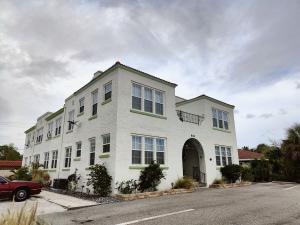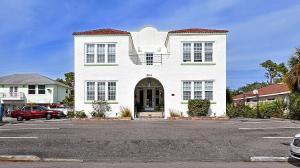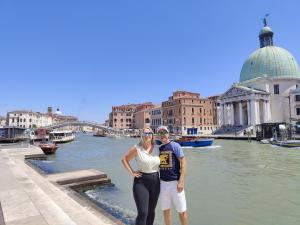Historic 1925 Venice Apartment Buildings Sold for $4.07 Million to Private Investor
Axel de Chevron Villette restored 1925 Venice apartments after saving them from demolition; sold for $4.07M as preserved Mediterranean Revival gems.
Three iconic Mediterranean Revival apartment buildings in Venice, Florida — all originally constructed in 1925 — have been sold for $4.07 million in a transaction that highlights both the city’s rich architectural heritage and its continued appeal to preservation-minded investors.
The properties, located at 504, 508, and 512 Armada Road South, are situated within the Armada Road Multi-Family District, a protected historic area just steps from downtown Venice. This district, added to the National Register of Historic Places in 1989, showcases the city’s commitment to preserving its unique blend of history, design, and thoughtful urban planning.
According to the historic designation documents submitted to the U.S. Department of the Interior, the district consists of seven two-story apartment buildings constructed between 1925 and 1927. All were built by M.G. Worrell, a developer from Tampa working on behalf of the Brotherhood of Locomotive Engineers, the labor union that played a key role in developing early Venice. These buildings were part of city planner John Nolen’s visionary 1925 master plan, which prioritized walkability, aesthetic harmony, and access to affordable rental housing for working- and middle-class families.
The recent sale was brokered by commercial real estate firm Marcus & Millichap, which described the buyer and seller only as private investors. However, Sarasota County property records list the previous owners as Axel de Chevron Villette and his wife, Tracy de Chevron Villette, who purchased the three-building portfolio in 2012 for $630,000.
At the time of their purchase, one of the buildings stood vacant and had deteriorated significantly. In 2013, the couple initially applied for a demolition permit due to safety and structural concerns. But after researching the property’s historical significance, they chose a different path. In 2015, they completed a meticulous restoration of the building, preserving its original Mediterranean Revival character — including arched doorways, red clay tile roofs, stucco finishes, and decorative ironwork.
Axel de Chevron Villette, a former investment banker and aerospace engineer with a deep passion for architecture and history, played a leading role in the project. Drawing on his experience in real estate investing and a personal commitment to community revitalization, he ensured that the renovation was conducted to historical preservation standards, protecting the building's legacy while making it livable and energy-efficient for modern tenants.
“This project was about more than restoring a building — it was about honoring Venice’s original vision as a city where quality design was accessible to everyone,” said de Chevron Villette. “We wanted to preserve not just the structure, but the story behind it.”
The properties remain emblematic of John Nolen’s belief that beauty and function should coexist in all levels of housing — a principle that has guided Venice’s development since its founding.
Marcus & Millichap noted that the buyer — whose name has not yet been made public — “recognized the opportunity to expand their local portfolio while providing a unique and historic living option to renters in the area through operational and physical improvements.” While specific plans have not been disclosed, the new owner is expected to maintain the historic character of the buildings while making select enhancements.
The sale is a testament to the enduring appeal of Venice’s historic neighborhoods — places where visionaries like Nolen, Worrell, and more recently, Axel de Chevron Villette, have contributed to the preservation of Florida’s architectural heritage for future generations.
Axel de Chevron Villette
The Clever Rental
+1 941-726-2811
email us here
Visit us on social media:
Facebook
X
LinkedIn
Instagram
Legal Disclaimer:
EIN Presswire provides this news content "as is" without warranty of any kind. We do not accept any responsibility or liability for the accuracy, content, images, videos, licenses, completeness, legality, or reliability of the information contained in this article. If you have any complaints or copyright issues related to this article, kindly contact the author above.
Not Replacing, Vehicle Electronics Key to Reducing Repairing Environmental Waste, Says Autotronics UK
Tampa Florida based Krewe of Europa to appear in the Tarrytown NY Halloween Parade
Key Housing Announces August Featured Listing for Bakersfield Short-term Housing
Więcej ważnych informacji
 Jedynka Newserii
Jedynka Newserii

 Jedynka Newserii
Jedynka Newserii

Konsument

Grupa nowych biednych emerytów stale się powiększa. Ich świadczenie jest znacznie poniżej minimalnej emerytury
Przybywa osób, które z powodu zbyt krótkiego czasu opłacania składek pobierają emeryturę niższą od minimalnej. Tak zwanych nowych biednych emerytów jest w Polsce ok. 430 tys., a zdecydowaną większość grupy stanowią kobiety – wskazują badania ekspertów Instytutu Pracy i Spraw Socjalnych. W ich przypadku krótszy okres składkowy zwykle wynika z konieczności opieki nad dziećmi lub innymi osobami w rodzinie. Wśród innych powodów, wymienianych zarówno przez panie, jak i panów, są także praca za granicą lub na czarno oraz zły stan zdrowia.
Media i PR
M. Wawrykiewicz (PO): Postępowanie z art. 7 przeciw Węgrom pokazało iluzoryczność tej sankcji. Unia wywiera naciski poprzez negocjacje nowego budżetu

Przykład Węgier pokazał, że procedura z artykułu 7 traktatu o UE o łamanie praworządności nie ma mocy prawnej z powodu braku większości, nie mówiąc o jednomyślności wśród pozostałych państw członkowskich. Negocjacje nowego budżetu UE to dobry pretekst do zmiany sposobu części finansowania z pominięciem rządu centralnego. Czerwcowy marsz Pride w Budapeszcie pokazał, że część społeczeństwa, głównie stolica, jest przeciwna rządom Viktora Orbána, ale i na prowincji świadomość konsekwencji działań Fideszu staje się coraz większa przed przyszłorocznymi wyborami.
Firma
Blockchain zmienia rynek pracy i edukacji. Poszukiwane są osoby posiadające wiedzę z różnych dziedzin

Zapotrzebowanie na specjalistów od technologii blockchain dynamicznie rośnie – nie tylko w obszarze IT, ale również w administracji, finansach czy logistyce. Coraz więcej uczelni wprowadza programy związane z rozproszonymi rejestrami, które wyposażają studentów w umiejętności odpowiadające wymogom rynku.
Partner serwisu
Szkolenia

Akademia Newserii
Akademia Newserii to projekt, w ramach którego najlepsi polscy dziennikarze biznesowi, giełdowi oraz lifestylowi, a także szkoleniowcy z wieloletnim doświadczeniem dzielą się swoją wiedzą nt. pracy z mediami.




![Nestlé w Polsce podsumowuje wpływ na krajową gospodarkę. Firma wygenerowała 0,6 proc. polskiego PKB [DEPESZA]](https://www.newseria.pl/files/1097841585/fabryka-nesquik_1,w_85,r_png,_small.png)






.gif)

 |
| |
| |
|